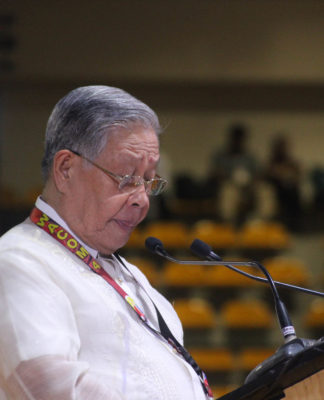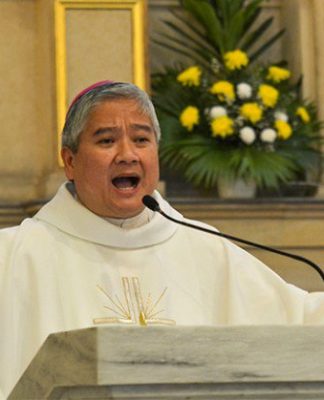the eight-year term of Father Tamerlane Lana O.P. as UST Rector will be best remembered as a time when the University had major improvements in its faculty profile, research capabilities, and infrastructure, amid crucial moments in Philippine history.
When Lana first assumed office in 1998 to become UST’s 93rd Rector, he vowed to work for a “stronger UST.” He sought to foster a paradigm of education that was “formative” and “integrative” and a management style that was “collaborative,” by focusing on four key pressing issues: faculty development, research invigoration, community development and a stronger image of UST as a Christian academic community.
The Rector pushed for an improved faculty profile. Among the 1,500 faculty members when Lana started his term, 319 were Master’s degree holders while 372 were Doctorate degree holders. Today, 65 per cent of the faculty members have completed their graduate studies.
Under Lana’s term, UST was able to maintain its 15 centers of excellence and centers of development that had been declared by the Commission on Higher Education during the term of Fr. Rolando de la Rosa. In addition, Lana was able to work that 42 per cent or 36 of its 85 programs be accredited. The Professional Regulatory Commission has also declared UST as the top performing private school in 10 or more licensure examinations.
New and innovative courses were also implemented such as the College of Commerce’s B.S. Entrepreneurship, the College of Education’s B.S.E. Early Childhood Development, the College of Science’s B.S. Applied Physics, the College of Rehabilitation Science’s B.S. Sports Science, the AB-BSE Social Science of the Faculty of Arts and Letters and the College of Education, and six new programs of the Graduate School—Ph.D. in Theology, M.A. Theology major in Social and Pastoral Communication, M.A. in Clinical Audiology, M.A. in Education, M.A. in Health Professor’s Education, and Master’s of Science in Physical Therapy.
It was also during Lana’s term when the College of Fine Arts and Architecture was divided into the College of Architecture and the College of Fine Arts and Design, the Institute of Physical Therapy was raised to the College of Rehabilitation Sciences, and the Institute of Physical Education and Athletics was created to sustain UST’s much-touted sports prowess.
The poor research culture in the University was a major challenge when Lana first assumed office. But UST researchers found solace in the Thomas Aquinas Research Complex (TARC), which brought under one roof the research facilities of the University in education, natural sciences, and social sciences. In the last academic year, the UST Research Center conducted 202 research projects.
To extend the University’s presence outside of Manila, the Rector spearheaded the expansion projects in Sta. Rosa, Laguna; General Santos City, South Cotabato; and Sri Lanka. The Santa Rosa site, which will house the UST Faculty of Medicine and Surgery, Faculty of Engineering, and other technology and health-related courses was launched last April 19.
Lana’s administration was also responsible for the creation of the Tan Yan Kee Student Center, Alfredo M. Velayo College of Accountancy and Multi-Deck Car Park. More importantly, Lana led the implementation of the bold smoke-free campus campaign. His term also gave birth to the creation of new innovations such as the e-Learning Access Program (e-LEAP) and online public access catalogue of the Central Library (LORENZO).
Despite his rather quiet looks, Lana was surely aware and informed as he guided UST through critical political and social turmoil. He led the University contingent in EDSA II, which toppled President Joseph Estrada in 2001. After the murder of Mechanical Engineering sophomore Mark Welson Chua in March 2001, Lana, then president of the University Belt Consortium, rallied for the abolition of the Reserved Officers Training Corps (ROTC) program. This led to the enactment of the National Service Training Program in January 2002 that made ROTC non-compulsory and offered alternatives to sollege students in doing national service.
The University also continued to take on major roles in the Church’s evangelical mission. Together with the Vatican’s Pontifical Academy for Life and the Catholic Bishops Conference of the Philippines, UST sponsored the International Congress on Bioethics December of last year. Doctors, bioethicists, clergymen, and educators all over the world discussed current bioethical issues and were one in upholding the Church’s stand against threats to the sanctity of family and life. By 2011, Lana hopes to establish UST, Asia’s oldest institution of higher learning as the Center for Contextualized Theology in Asia.
As Lana relinquishes the rectorial mace, he will be leaving a legacy of intelligence, and innovation. The Millenial Rector might not be able to accomplish all of his goals during his term, but for sure, his passion and commitment to promote education, research, community and evangelization, which the University has been providing for almost 400 years, will always be remembered.

















